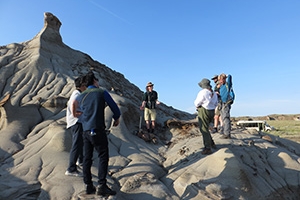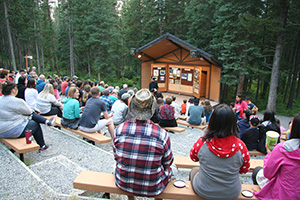Background
Interpretation is "a communication process designed to reveal meanings and relationships of cultural and natural heritage to the public" (Interpretation Canada 1976). This process can lead to understanding, appreciation, and protection (Tilden 1977; Ham 2009). The goals of interpretation can fit into six main categories of outcomes: enjoyment of the experience, behavior change, learning, attitude change, connections to the place, and making positive memories (Benton 2009, Weiler and Ham 2010).
To guide programming, researchers should evaluate the effectiveness of interpretive activities in achieving these outcomes (Beckmann 1999) within theoretical framework relevant to these outcomes. There is a growing body of research on visitors' awareness and use of park interpretive programs; however, there is a lack of quality research on the policies, practices, and outcomes of interpretive programming (Kim et al. 2011, Duerden and Witt 2010, Moscardo 2014).


Implications
This research will provide theoretical and practical insights about park interpretation services. This first comprehensive study on interpretive effectiveness in Canada will provide leadership for interpretive programs in national, provincial, and municipal park systems. The results will improve engagement with park visitors, help align interpretive objectives and outcomes, and assist with interpreter training, inspiration, and reflection (Christie and Mason 2003, Gilson 2015). A consistent approach to evaluating outcomes (Weiler and Ham 2010) will allow comparisons among jurisdictions and provide benchmarks for future use. Park agencies will benefit by analyzing their interpretive programs through this study's evaluation lens.
References
- Beckmann EA. 1999. Evaluating visitors' reactions to interpretation in Australian national parks. Journal of Interpretation Research, 4(1):5-19.
- Benton GM. 2009. From principle to practice: Four conceptions of interpretation. Journal of Interpretation Research 14(1):7-31.
- Christie MF and Mason PA. 2003. Transformative tour guiding: Training tour guides to be critically reflective practitioners. Journal of Ecotourism 2(1):1-16.
- Duerden MD and Witt PA. 2010. The impact of direct and indirect experiences on the development of environmental knowledge, attitudes, and behavior. Journal of Environmental Psychology 30(4):379-292.
- Gilson JF. 2015. An exploration into inspiration in heritage interpretation through virtual world cafe. Victoria, British Columbia: Royal Roads University (Canada).
- Ham SH. 2009. From interpretation to protection: Is there a theoretical basis? Journal of Interpretation Research 14(2):49-57.
- Interpretation Canada Homepage [Internet] [cited 2013. Available from: www.interpscan.ca/.
- Kim AK, Airey D, Szivas E. 2011. The multiple assessment of interpretation effectiveness: Promoting visitors' environmental attitudes and behavior. Journal of Travel Research 50(3):321-34.
- Moscardo G. 2014. Interpretation and tourism: Holy grail or emperor's robes? International Journal of Culture, Tourism and Hospitality Research 8(4):462-476.
- Tilden F. 1977. Interpreting our heritage. 3rd ed. Chapel Hill, NC: University of North Carolina Press.
- Weiler B and Ham SH. 2010. Development of a research instrument for evaluating the visitor outcomes of face-to-face interpretation. Visitor Studies 13(2):187-205.